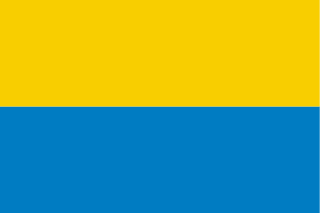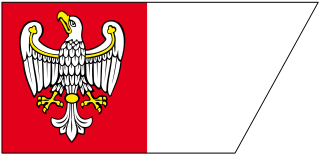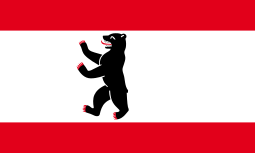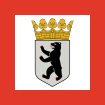
The national flag of Germany is a tricolour consisting of three equal horizontal bands displaying the national colours of Germany: black, red, and gold. The flag was first sighted in 1848 in the German Confederation. The flag was also used by the German Empire from 1848 to 1849. It was officially adopted as the national flag of the German Reich from 1919 to 1933, and has been in use since its reintroduction in Federal Republic of Germany in 1949.

The coat of arms of Germany displays a black eagle with a red beak, a red tongue and red feet on a golden field, which is blazoned: Or, an eagle displayed sable beaked langued and membered gules. This is the Bundesadler, formerly known as Reichsadler. It is one of the oldest coats of arms in the world, and today the oldest national symbol used in Europe.

The coat of arms of Bern, along with the associated flag and heraldic colours, are used both by the Swiss city of Bern and by the canton of the same name. They were also used by the former district of Bern until its abolition in 2009.

The German state of Brandenburg has a coat of arms depicting a red eagle.
This is a list of coats of arms of Germany.

The coat of arms of Berlin is used by the German city state as well as the city itself. Introduced in 1954 for West Berlin, it shows a black bear on a white shield. On top of the shield is a special crown, created by the amalgamation of the mural crown of a city with the so-called people's crown, used in Germany to denote a republic. Berlin's various boroughs use their own emblems.

The coat of arms of the German state and city of Hamburg is a kind of national emblem. The coat of arms and the flags are regulated by the constitution of Hamburg and law. The colors of Hamburg are white and red. One of the oldest versions of the castle is found on a seal in 1241.

There are three flags of Hamburg, Germany. The Landesflagge, the State flag of Hamburg (Staatsflagge) and the admiralty flag (Admiralitätsflagge) consist of the coat of arms of Hamburg on a red flag.

The civil flag that serves as the symbol of the state of Mecklenburg-Vorpommern, Germany, consists of five horizontal stripes, that are from the top to bottom: blue (ultramarine), white, yellow, white, and red (vermilion). It was designed by Norbert Buske and adopted on 29 January 1991. It is a combination of the historical flags of the Mecklenburg and Western Pomerania.

The flag of Bremen consists of at least eight equal horizontal stripes of red alternating with white, and checked at the hoist. It is colloquially known as Speckflagge. The civil flag does not contain the coat of arms. The state flag exists in three versions

The flag of Brandenburg is a horizontal bi-color of red over white, with the arms of the state (land), in the center. The coat of arms of the state shows on a shield in white (silver) a red eagle, looking to the right, with wings decorated with trefoils in gold and armored gold. In its current form, the flag was adopted on 30 January 1991, with further enshrinement in Article 4 of the Constitution of the State of Brandenburg.

The flag that serves as the symbol of the historical and geographical region of the Upper Silesia, and as one of the symbols of the Silesian people, is divided horizontally into two stripes: yellow on the top and blue on the bottom. It originated as the flag of the Province of Upper Silesia adopted in 1920, with its colours based on the coat of arms of Upper Silesia. The flag is also popular symbol used by the Silesian Autonomy Movement.

The coat of arms that serves as the symbol of the city of Szczecin in West Pomeranian Voivodeship, Poland depicts the head of a red griffin with a yellow (golden) beak wearing a yellow (golden) crown, placed on the blue background.

The flag is the symbol of the city of Szczecin in West Pomeranian Voivodeship, Poland.

The flag of the Greater Poland Voivodeship, Poland is a trapezoid divided into red stripe on the right, and white stripe on the left, with a white eagle with yellow (golden) beak, legs, stripes on its wings, and a ring on its tail, featured in the middle of the red stripe. It was adopted in 2000.

The flag that serves as the symbol of the historical and geographical region of the Western Pomerania is divided horizontally into two stripes: light blue on the top and white on the bottom. It originated as the flag of the Province of Pomerania, Prussia, used from 1882 to 1935. Since 1996, it is officially recognized as the symbol of the historical region of Western Pomerania within Mecklenburg–Western Pomerania, Germany.

The flag that serves as the symbols of the Koszalin County, West Pomeranian Voivodeship, in northwest Poland was established in 2001, and the coat of arms, in 2002.

The coat of arms and flag that serve as the symbols of the Police County, in West Pomeranian Voivodeship, Poland were established on 28 June 2000. They were designed by Radosław Gaziński.

The flag that serves as the symbol of the historical and geographical region of the Mecklenburg is divided horizontally into two stripes: light blue on the top and white on the bottom. It originated as the flag of the Grand Duchy of Mecklenburg-Schwerin, adopted in 1813. Since 1996, it is officially recognized as the symbol of the historical region of Mecklenburg within Mecklenburg-Vorpommern, Germany.





































